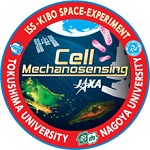This is an archive of information released in the past.
Disclaimer: It may contain broken links or outdated information. Some parts may not function in current web browsers.
*Visit https://humans-in-space.jaxa.jp/en/ for the latest information.

Experiment
- News
- Kibo Utilization Strategy
- Kibo Utilization Plan
- List of JAXA's Utilization Themes
- Experiment Facilities
- Space Environment Utilization
- Archive
Evaluating mechanisms of cellular response to gravitational force and obtaining basic data helpful in developing new medicines for muscle atrophy
Identification of gravity-transducers in skeletal muscle cells: Physiological relevance of tension fluctuations in plasma membrane (Cell Mechanosensing experiment)
Ground research strongly suggests that skeletal muscle cells possess unique sensors (receptors) for mechanical stress. However, it has long remained unknown how cells sense mechanical (or gravitational) stress and connect the perception with responses (including growth, proliferation, and differentiation).
Using cells cultured under microgravity conditions, this study aims to reveal the mechanisms cells use to sense mechanical (or gravitational) stress, in order to elucidate the mechanism of muscle atrophy under microgravity conditions.
![]() TOPICS:
TOPICS:
- Easy-to-understand lesson on space experiments: Cell Mechanosensing experiment
Pikaru, a member of the investigation team for the space experiments, interviews the Doctor to understand the Cell Mechanosensing experiment.
- Background and Objective
In cells, gravitational force causes mechanical stress. To investigate the mechanisms cells use to sense mechanical stress, we will use microgravity conditions in space to produce a condition where no weight is placed on cells.
We will investigate how cells sense mechanical stress (including gravitational force) and respond to the mechanosensing. The objective of this experiment is to investigate the existence of sensors for gravitational force, which have never been reported. In addition, the effectiveness of medicines for muscle atrophy, which occurs under zero-gravity conditions, will be verified at the cellular level. - Outline of the Experiment
This experiment will be performed at three launching opportunities. The first experiment will involve cultured cells of mammals (rats and mice). The cells will be cultured in the Cell Biology Experiment Facility (CBEF) onboard Kibo and furthermore cultured after addition of various medicines. In the final step, the cells will be treated with chemicals that preserve genetic material and frozen for return to Earth. The second and third experiments will involve cultured cells of rats, mice and Xenopus laevis, into which fluorescent proteins have been incorporated. The live cells will be observed with a fluorescent microscope onboard Kibo and then chemically fixed and refrigerated for return to Earth. - This is the Point!
This research aims to elucidate how cells sense gravitational force, to determine the following chemical signaling mechanism involved, and finally, to resolve the question “Why and how do muscles atrophy in space or in a bedridden condition occur?” for the first time. - Detailed explanation for those who want to learn more
This experiment will be performed at three launching opportunities after February 2014.

Masahiro SOKABE
Graduate School of Medicine, Nagoya University
Project Professor
Area of Research: biophysics, gravitational physiology, cerebral neurophysiology
Collaborating researchers:
Takeshi NIKAWA, Institute of Health Biosciences, University of Tokushima Graduate School
Takeshi KOBAYASHI, Graduate School of Medicine, Nagoya University
Shigetada KONDO, Institute of Health Biosciences, University of Tokushima Graduate School
Akira HIGASHIBATA, ISS Science Project Office, JAXA
Masaki SHIRAKAWA and Sachiko YANO, Space Environment Utilization Center, JAXA
| Copyright 2007 Japan Aerospace Exploration Agency | Site Policy |
